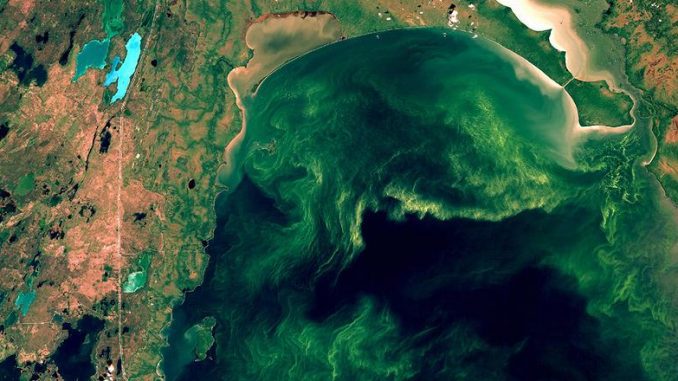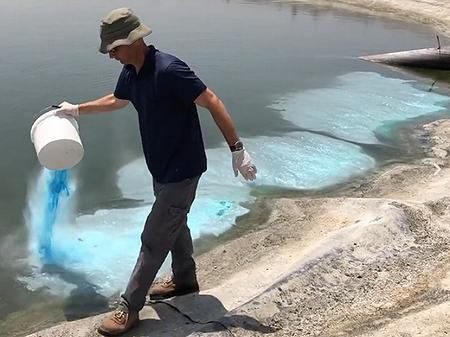
TZUR HADASSAH, Israel, August 3, 2021 (ENS) – BlueGreen Water Technologies, Ltd., a global watertech company that provides innovative solutions to toxic algae blooms, has been named the Global Water Awards 2021 Breakthrough Technology Company of the Year by the publisher Global Water Intelligence (GWI).
A young company with offices in Oxford, England; Austin, Texas; and Shanghai, China, Global Water Intelligence publishes magazines, databases, and reports on the international water industry.
BlueGreen CEO, Eyal Harel said, “As global warming continues to threaten our waterways and aquatic ecosystems, it is more important than ever to restore our Earth’s most precious resource – water.”
BlueGreen Water Technologies was selected as the early-stage technology company which has made the most impressive commercial breakthrough into the global water technology market. Their technology treats cyanobacteria blooms in bodies of water regardless of location, size, or shape.
Its patented product formulations, Lake Guard™️ Blue and the Lake Guard™️ Oxy, float on the surface of an infected water body to ignite a “suicide response” within the toxic algal species.
The product engages with toxic algal aggregates and eliminates them selectively by triggering the cyanobacteria’s natural “suicide” response, which allows more beneficial species to grow in the ecological vacuum created by the suicides.
The harmful algal bloom dissipates in hours, without harming the aquatic ecosystem’s plants or animals.
Both BlueGreen products are approved by the U.S. Environmental Protection Agency and meet the National Sanitation Foundation NSF/ANSI/CAN 60 standard for drinking water. NSF/ANSI/CAN 60 is the American National Standard for evaluation of water treatment chemicals and is required by regulation or law in most U.S. states and Canadian provinces.
“The water industry is essential in helping protect people around the world, despite the lack of resources, extreme lockdown curfews and financial difficulties,” said GWI Publisher Christopher Gasson. “Across the industry, all winners worked hard to ensure the public’s access to water, while also pushing forward to complete major projects, finalize deals, and innovate and accelerate in all areas of business. Now more than ever, it is essential that we recognize these achievements.”

An algal bloom is the overgrowth of microscopic algae or algae-like bacteria in fresh, salt, or brackish waters. Depending on the type of algae or bacteria that cause it, an algal bloom may produce stinking scum, foam, froth, or a slick. Algal blooms can be blue-green, yellow, brown, pink, and red.
Not all algal blooms are toxic, but research indicates that a growing number are. A harmful algal bloom, or HAB, is a bloom that produces toxins that are dangerous to humans and potentially to other organisms as well.
Cyanobacteria are indeed bacteria, but they perform photosynthesis, like algae do, and are often called blue-green algae.
Contamination, trash, and an over-colonization of cyanobacteria can push entire aquatic ecosystems into decline. When cyanobacteria populations explode they form harmful algal blooms, which harm drinking water supplies, freshwater ecosystems, recreational activities and regional economies.
The Natural Resources Defense Council explains that climate change fuels harmful algal blooms.
“Burning fossil fuels, deforestation, and land development are increasing the amount of carbon dioxide in the atmosphere. This fuels harmful algal blooms because cyanobacteria can feed on the carbon dioxide not only present at the surface of a water body but also dissolved in the water. And when algae die and sink to the bottom of a freshwater body, they decompose and release carbon that was once sequestered, providing more fuel for cyanobacteria growth,” Melissa Denchak and Melanie Sturm wrote on the NRDC website in August 2019.
Climate change and ever-more severe droughts can increase competition for ever-scarcer freshwater supplies. Reduced flows in waterways means the remaining water will be warmer and more stagnant, creating conditions ripe for algal blooms.
With thousands of commercial applications in four continents and proprietary satellite technology in use, BlueGreen operates on a global scale to track toxic blue-green algae blooms and treat them to rehabilitate the infected water sources.
“We are extremely proud that our technology is enabling life by making water safe again,” said Dr. Moshe Harel, founder, inventor and chief strategy officer at BlueGreen. “It is an honor to be selected as the Breakthrough Technology Company of the Year and to be recognized for the groundbreaking work and commitment to enable people access to clean water everywhere every day.”
BlueGreen completed its treatment of Chippewa Lake, the largest inland natural lake in Ohio, in August 2019. The treatment broke five years of high toxicity levels in the lake, which has remained free of toxic algae ever since.
The company has had global success in Nanhu Lake in Yueyang, China, and in South Africa at both Roodeplaat Dam in 2020 and Setumo Dam this year.
The State of Florida recently retained the company to remediate harmful algal blooms in Lake Minnela. It was also called by Florida’s Department of Environmental Protection for emergency deployments designed to prevent cyanobacteria buildup and proliferation from Lake Okeechobee through the C-44, a 21-mile-long canal into Florida’s waterways last October; and in the C-43, an 80-mile-long canal, in June.
“Cyanobacterial blooms continue to increase in both frequency and severity from season to season around the world, endangering both humans and animals,” said Professor Aaron Kaplan, who chairs BlueGreen’s Scientific Board. “BlueGreen’s outstanding impact on the aquatic environment supports the global collective effort to rehabilitate the environment and follows the United Nations’ Sustainable Development Goals to protect the planet.”
Featured image: Harmful bluegreen algal bloom on Canada’s Lake Winnipeg is visible from space. Immense blooms have appeared in the northern part of Lake Winnipeg in the last decade with hundreds of square kilometers of the lake covered with a thick toxic layer of cyanobacteria, August 2, 2017 (Photo by Sentinel Hub)



